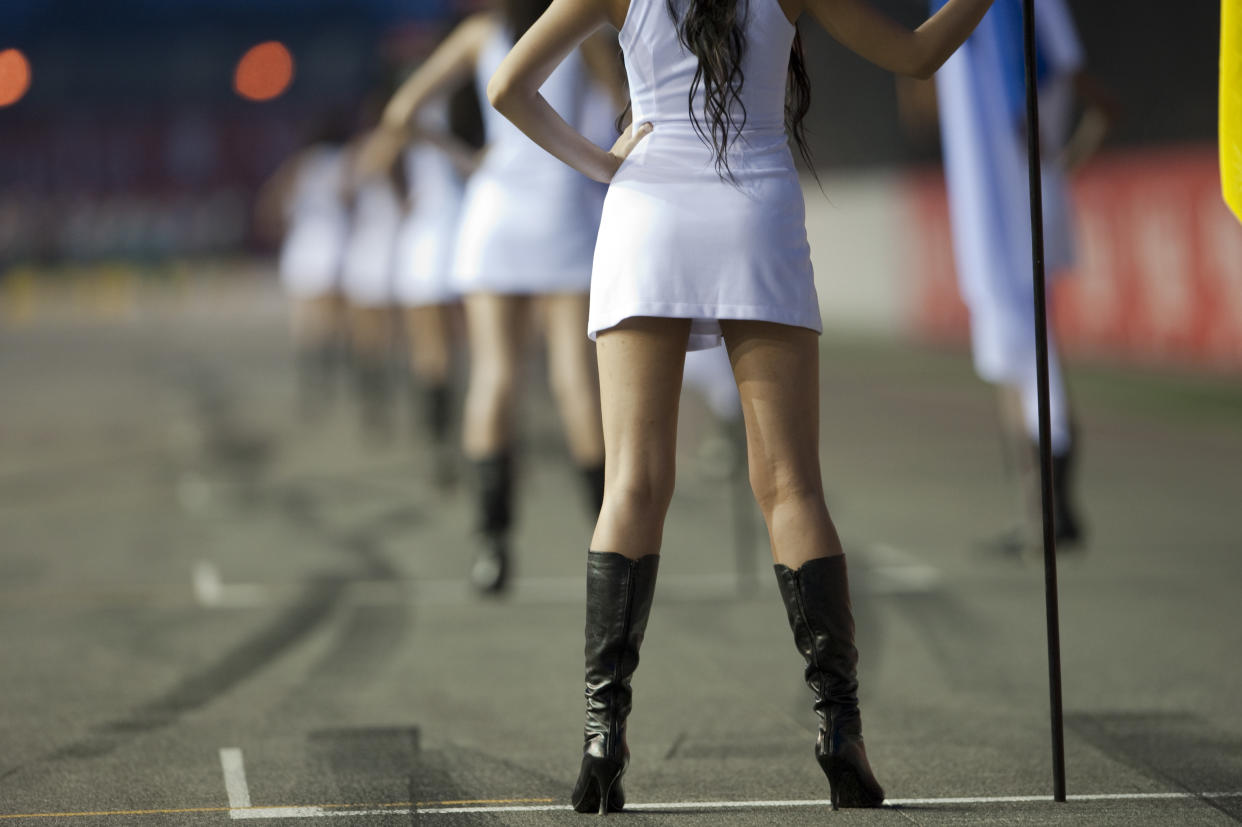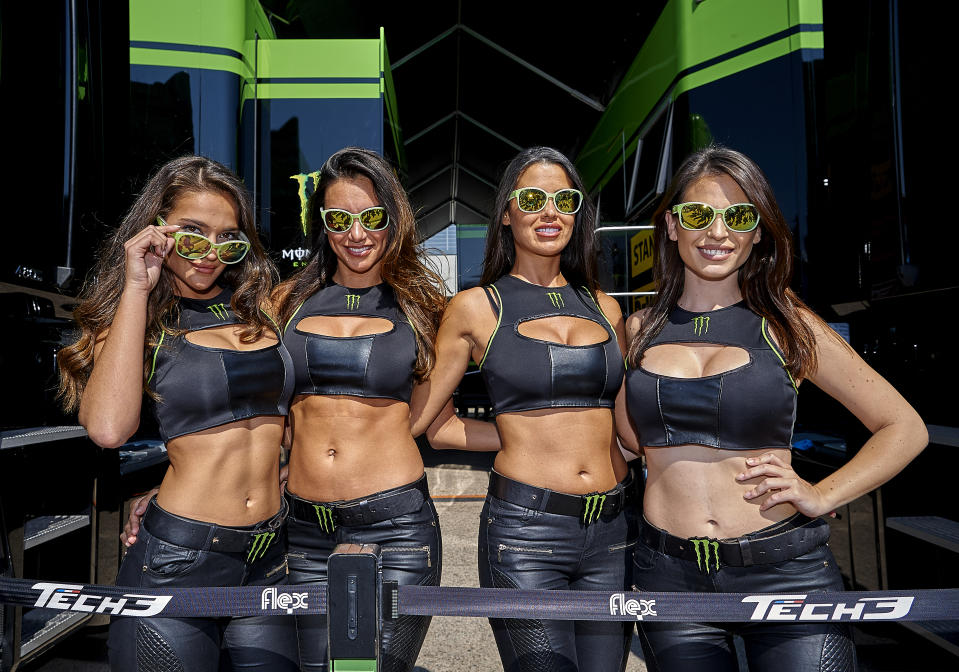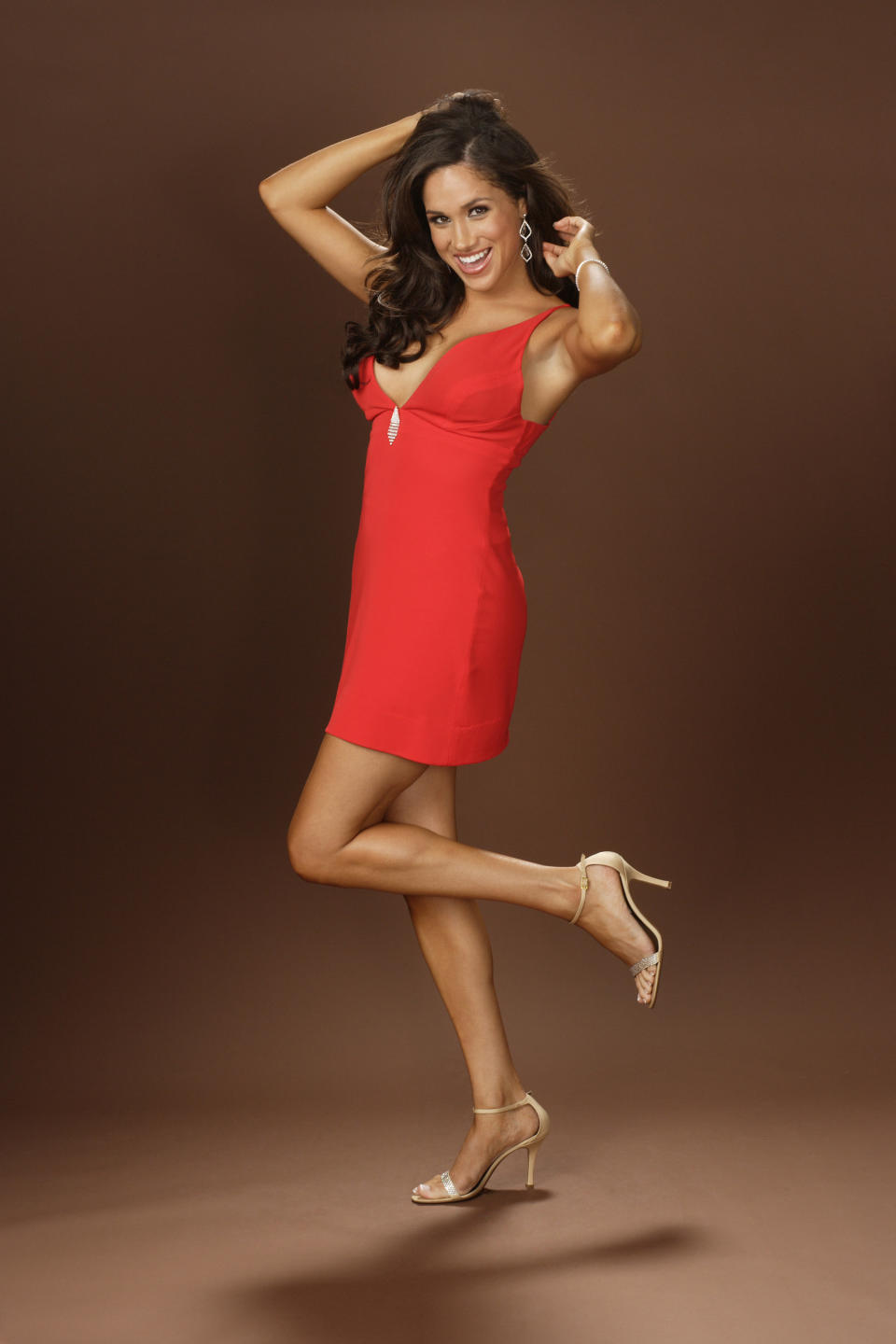Are 'grid girls,' auto-show models, and Monster Energy Girls outdated?

Formula 1, the world-famous racing series, will no longer hire “grid girls,” scantily-clad models who parade around the driving track to rally fans.
“Over the last year we have looked at a number of areas where we felt we needed updating so as to be more in tune with our vision for this great sport,” Sean Bratches, a Formula 1 rep, wrote Wednesday in a press release, of the decision that goes into effect on March 25.
“While the practice of employing grid girls has been a staple of Formula 1 Grands Prix for decades, we feel this custom does not resonate with our brand values and clearly is at odds with modern-day societal norms. We don’t believe the practice is appropriate or relevant to Formula 1 and its fans, old and new, across the world.”
The concept of “grid girls” has often been under fire for being sexist and objectifying. One such example is from 2015 when F1 driver Lewis Hamilton sprayed a grid girl in the face with champagne after winning the Chinese Grand Prix. However, the 22-year-old model, Liu Siying, told the UK’s Guardian of the incident, “It lasted for only one or two seconds, and I didn’t think too much about it.”

But there’s no clear-cut answer as to whether these roles are outdated or should be eliminated in our #MeToo and #TimesUp era. While some cheered Formula 1’s decision in favor of women’s equality, others claimed the move was antifeminist, particularly because eliminating these jobs now leaves many unemployed.
“Because of these feminists, they’ve have cost us our jobs!” tweeted grid girl Lauren Jade Pope, who did not return Yahoo Lifestyle’s request for comment. “I have been a grid girl for 8 years and I have never felt uncomfortable! I love my job, if I didn’t, I wouldn’t do it! No one forces us to do this! This is our choice!”
Thank you @F1 for deciding to stop using grid girls. Another sport making a clear choice about what they want to stand for:
“We feel this custom does not resonate with our brand values and clearly is at odds with modern day societal norms.” https://t.co/Rrwxf5VcjY— Women's Sport Trust (@WomenSportTrust) January 31, 2018
There’s no better way to show you respect women than by firing them all https://t.co/ezPvoA4LpC
— adam22 (@adam22) January 31, 2018
Depriving young women of employment. Another stunning victory for western feminism. https://t.co/O59xxzaocE
— Paul Joseph Watson (@PrisonPlanet) January 31, 2018
1. Formula one grid girls do not wear bikinis. 2. We are there to advertise teams and sponsors so we have a purpose. 3. Women depend on this income, why should we lose our jobs because somebody has got their knickers in a twist. You deserve Ebola #goodriddance
— Lauren-Jade (@laurenjadepope) January 31, 2018
Several days prior to the Formula 1 announcement, the Professional Darts Association (PDA) in the U.K. made a similar move to ban “walk-on girls,” women wearing sparkly dresses and stilettos who escort male players to the stage. “We regularly review all aspects of our events and this move has been made following feedback from our host broadcasters,” a PDA spokesperson told the BBC. The statement prompted mixed reviews and the launch of a petition signed by more than 41,000 people that said, “I want to keep tradition in darts and keep women in a job.”
The Detriot Free Press also reported that during January’s North American International Auto Show in Detroit, “booth girls,” who traditionally stood by the cars to entice potential buyers, were replaced by blazer-wearing “product specialists,” expert in their knowledge of vehicles.
On Thursday, Susie Wolff, a former Formula 1 test driver, wrote in the Guardian that ending grid girls was hopefully part of a broader effort to attract female drivers in a sport dominated by men.

“’Grid girls’ were a tradition within the sport,” Wolff wrote. “At most races, they are well dressed and representing top luxury brands. At the Austrian Grand Prix they were in traditional dress (the dirndl) and it was perceived as an honor to be picked as a grid girl for an F1 Grand Prix.”
She added, “During my time racing in German Touring Cars for Mercedes-Benz, I can recall getting into one conversation with a grid girl while waiting for my parade lap to start. She was a medical student who found it fascinating to be so close to the racing car and on the grid just before the race start.”
“You can say, on a positive note, that the owners of F1 have made a clear statement with their decision,” Wolff wrote. “This is not going to change overnight the lack of female representation in motorsport, but could it be a step in the right direction? I believe so.”
Ending the practice of grid girls will undoubtedly take a financial toll on the women who held those jobs. According to the Sun (U.K.), it’s unknown how much models earn through the gig, “but a number have said the money [supported] the early years of their modeling careers or their college or university education.”
A post shared by Coco (@coco) on Jan 14, 2018 at 12:39pm PST
As reported in September by USA Today, these types of gigs can supplement income for women working toward degrees in medicine and psychology. “It’s been nice being able to have my mental relaxation on the weekends and hanging out with my girlfriends and doing the things that I love,” Morgan Abel, an Indiana nurse who works as a Monster Energy Girl on weekends, told the paper.
And earlier this month, Coco Austin, wife of rapper Ice-T, claimed that her work as a motorcycle model in the 1990s broke ground for the body-positive movement during the “waif era,” when skinny bodies ruled pop culture.
Instagramming a vintage photo of herself wearing a neon-green string bikini and squatting in front of a bike, Austin wrote, “But I helped change the minds of what booty was. Today it’s a normal thing to see all different shapes & sizes, no one even thinks about it anymore. I helped history in some way. I don’t want to toss it aside like it was nothing. I’d like to think some of my modeling was meaningful. After tons of calendars, DVDs, over 100 magazine covers and editorials I’m still standing. Thank you for all years of support. Power to the booty and strong healthy women!”

Even Meghan Markle, a former “briefcase girl” on the game show “Deal Or No Deal” and now the future wife of Prince Harry, chalked up her gig to a career stepping stone.
“I would put that in the category of things I was doing while I was auditioning to try to make ends meet,” she told Esquire in November. “I went from working in the U.S. Embassy in Argentina to ending up on ‘Deal.’ It’s run the gamut. Definitely working on ‘Deal or No Deal’ was a learning experience, and it helped me to understand what I would rather be doing.”
Read more from Yahoo Lifestyle:
People offended by ‘Despacito’ dancer dressed ‘like a prostitute’ are missing the point
The best feminist responses to Courtland Sykes’s demands for a ‘home-cooked’ dinner
Melania Trump’s white State of the Union pantsuit might have a hidden meaning
Follow us on Instagram, Facebook, and Twitter for nonstop inspiration delivered fresh to your feed, every day.
